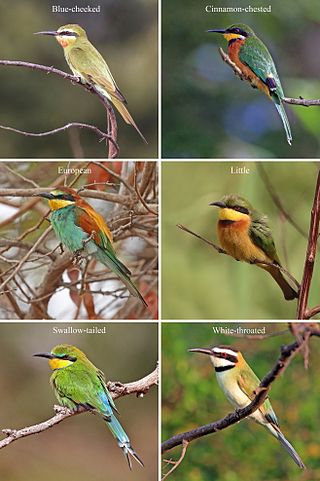
The bee-eaters are a group of non-passerine birds in the family Meropidae, containing three genera and thirty species. Most species are found in Africa and Asia, with a few in southern Europe, Australia, and New Guinea. They are characterised by richly coloured plumage, slender bodies, and usually elongated central tail feathers. All have long down-turned bills and medium to long wings, which may be pointed or round. Male and female plumages are usually similar.

The short-toed snake eagle, also known as the short-toed eagle, is a medium-sized bird of prey in the family Accipitridae, which also includes many other diurnal raptors such as kites, buzzards and harriers. The genus name Circaetus is from the Ancient Greek kirkos, a type of hawk, and aetos, "eagle". The specific gallicus means "of Gallia".

The vinaceous dove is a bird species in the pigeon family Columbidae that widely resident across the Sahel and Sudan (region).

The greater ani is a bird in the cuckoo family. It is sometimes referred to as the black cuckoo. It is found through tropical South America south to northern Argentina.

The black-throated trogon, also known as yellow-bellied trogon, is a near passerine bird in the trogon family, Trogonidae. Although it is also called "yellow-bellied trogon" it is not the only trogon with a yellow belly. It breeds in lowlands from Honduras south to western Ecuador and northern Argentina.

The African pygmy kingfisher is a small insectivorous kingfisher found in the Afrotropics, mostly in woodland habitats.

The roadside hawk is a relatively small bird of prey found in the Americas. This vocal species is often the most common raptor in its range. It has many subspecies and is now usually placed in the monotypic genus Rupornis instead of Buteo.

The mangrove cuckoo is a species of cuckoo that is native to the Neotropics.
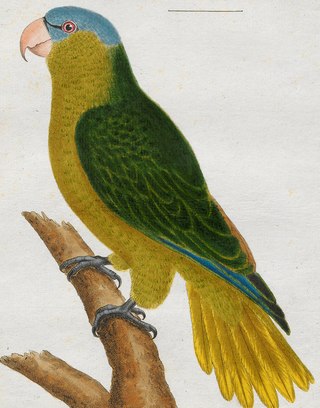
The black-lored parrot also known as the Buru green parrot, is a parrot endemic to the Indonesian island of Buru. It is a 40 cm (16 in) long green parrot with black lores, and a turquoise crown. Males have red beaks, and females are gray-brown. The singing is high pitched and more protracted as compared to similar species, such as great-billed parrot.

The glittering-throated emerald is a species of hummingbird in the "emeralds", tribe Trochilini of subfamily Trochilinae. It is found in Bolivia, Brazil, Colombia, Ecuador, the Guianas, Peru, and Venezuela.
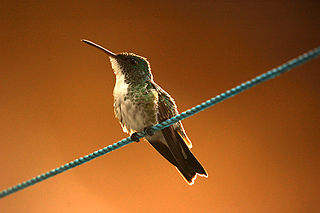
The plain-bellied emerald is a species of hummingbird in the "emeralds", tribe Trochilini of subfamily Trochilinae. It is found in Brazil, the Guianas, and Venezuela.

The Mascarene swiftlet or Mauritius swiftlet is a species of swift in the family Apodidae. It is found in Mauritius and Réunion, and the populations on the two islands have recently been confirmed to differ subspecifically. The nominate race francicus is found on Mauritius and the recently described race saffordi occurs on Réunion. Its natural habitats are subtropical or tropical moist lowland forest, subtropical or tropical high-altitude shrubland, subtropical or tropical high-altitude grassland, caves, arable land, and heavily degraded former forest. It is threatened by habitat loss.
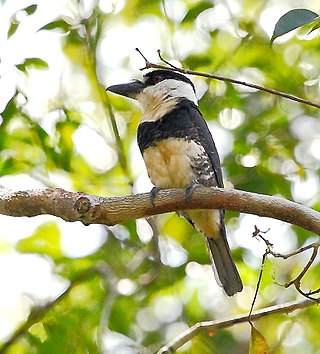
The Guianan puffbird is a species of bird in the family Bucconidae, the puffbirds, nunlets, and nunbirds. It is found in Brazil, French Guiana, Guyana, Suriname, and Venezuela. It was formerly considered to be conspecific with the white-necked puffbird and the buff-bellied puffbird with the English name "white-necked puffbird".

The short-tailed nighthawk is a species of nightjar in the family Caprimulgidae. It is found in Mexico, in every Central American country except El Salvador, in Trinidad and Tobago, and in every mainland South American country except Chile and Uruguay.

The rosy bee-eater is a species of bird in the family Meropidae. It is found in Angola, Benin, Burkina Faso, Republic of the Congo, Democratic Republic of the Congo, Ivory Coast, Equatorial Guinea, Gabon, Ghana, Nigeria, and Togo.
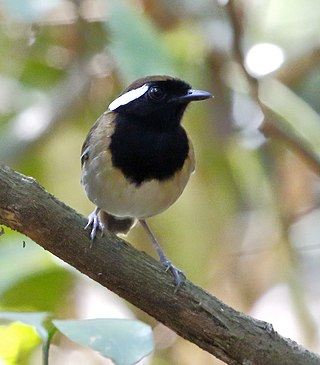
The chestnut-belted gnateater is a species of bird in the family Conopophagidae, the gnateaters. It is found in the Amazon Basin of northern Brazil, southern Colombia and eastern Peru and Ecuador; also the Guianan countries of Guyana, Suriname and eastern French Guiana. Its natural habitat is tropical moist lowland forest.

The Nubian woodpecker is a species of bird in the family Picidae. It is distributed widely in Central and Eastern Africa, from Chad in west to Somalia in east and Tanzania in south. It is a fairly common species with a wide range, the population seems stable, and the International Union for Conservation of Nature has rated its conservation status as being of "least concern".

The ringed woodpecker is a species of bird in the family Picidae that contains the woodpeckers, piculets, and wrynecks. It is found in northern Brazil, French Guiana, Guyana, Suriname, and western Venezuela. Its natural habitats are subtropical or tropical moist lowland forests and subtropical or tropical swamps.

The Buru green pigeon is a pigeon in the genus Treron. It is found in the forests of Buru in Indonesia. Many authorities split the species from the pompadour green pigeon complex.

The broad-billed roller is a member of the roller family of birds which breeds across tropical Africa and Madagascar in all but the driest regions. It is a wet season breeder, which migrates from the northern and southern areas of its range towards the moister equatorial belt in the dry season.





















